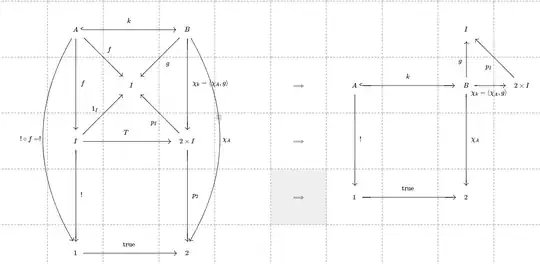I'm stuck on Exercise 4.5.1 of Goldblatt's, "Topoi: A Categorial Analysis of Logic".
It's in the topos $\mathbf{Bn}(I)$ of bundles over a set $I$. Goldblatt asks the reader to verify that
 $\tag{1}$
$\tag{1}$
satisfies the $\Omega$-axiom.${}^\dagger$ The construction is defined in the first link above.
For convenience: here $(A, f)\stackrel{k}{\rightarrowtail}(B, g)$ is an arbitrary, monic $\mathbf{Bn}(I)$-arrow, taken as an inclusion; $(I, \operatorname{id}_I)$ is the terminal object in $\mathbf{Bn}(I)$; $p_I$ is the projection $p_I(\langle x, y\rangle)=y$; $\top$ is defined by $\top(i)=\langle 1, i\rangle$; and $\chi_k$ is the product map $\langle\chi_A, g\rangle$, i.e., $$\chi_k(x)=\begin{cases}\langle 1, g(x)\rangle &: x\in A \\ \langle 0, g(x)\rangle &: x\notin A.\end{cases}$$
Thoughts: What I've done so far is replace $\chi_k$ with an arbitrary $\mathbf{Bn}(I)$-arrow $h: \langle B, g\rangle\to \langle 2\times I, p_I\rangle$ in $(1)$, supposing what I get is a pullback. Then I've run it though the definition of a pullback quite easily. I've had numerous stupid ideas about what to do next (with all manner of confusing diagrams) but to no avail.
I'd like a detailed solution, please.
It should be easier than I think it is. Maybe my problem is with bundles themselves. This is my second attempt at reading Goldblatt's book: last time I thought I had'm but got up to "11.4: Models in a Topos" - right where I wanted to be - before other commitments made me lose track entirely; now I'm about to read "4.8: $\Omega$ and comprehension".
Please help :)
$\dagger$: The $\Omega$-axiom is given on page 81, ibid., via the definition of a subobject classifier:
Definition: If $\mathbb{C}$ is a category with a terminal object $1$, then a subobject classifier for $\mathbb{C}$ is a $\mathbb{C}$-object $\Omega$ with a $\mathbb{C}$-arrow $\text{true}: 1\to\Omega$ that satisfies the following axiom.
$\Omega$-axiom: For each monic $f:a\rightarrowtail d$ there is one and only one $\mathbb{C}$-arrow $\chi_{f}:d\to\Omega$ such that $\chi_f\circ f=\text{true}\circ !$ is a pullback square.
